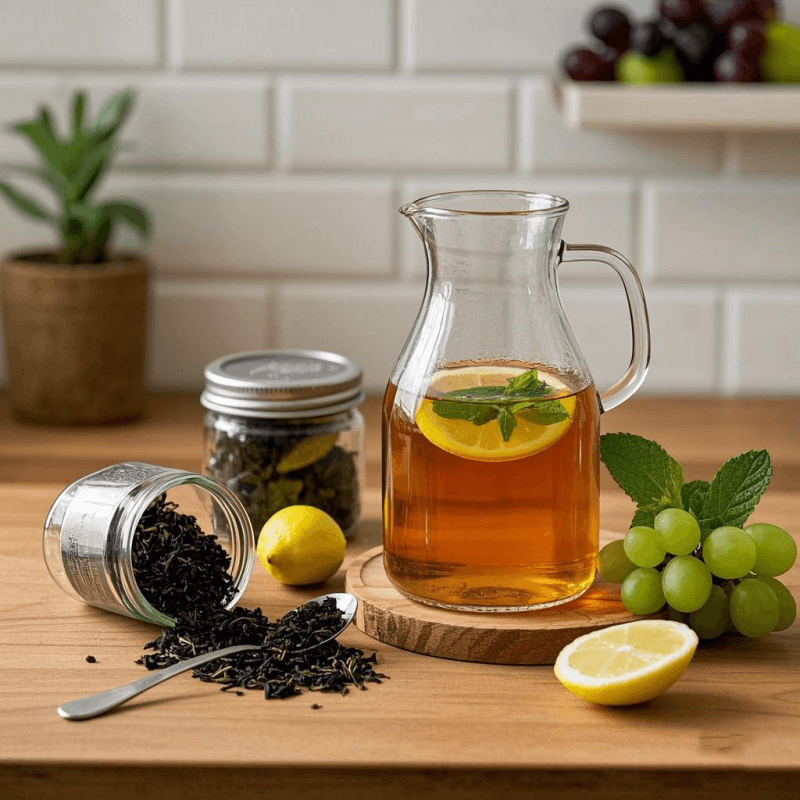1. Introduction: Why Cold Brew Oolong Tea Is a Must-Try

As temperatures rise, nothing beats a chilled, thirst-quenching drink—especially one that’s both delicious and good for you. Enter cold brew oolong tea: a smooth, low-bitterness alternative to hot tea that’s perfect for summer sipping. Unlike traditional hot-brewed tea, this method extracts flavor gently, resulting in a mellow, naturally sweet infusion that’s easy to enjoy all day.
But why choose cold brew oolong tea over other cold drinks? For starters, this tea itself is celebrated for its complex flavors, ranging from floral to roasted, and cold brewing amplifies its best qualities. It’s less bitter than hot-brewed versions, lower in acidity, and packed with the same antioxidants that make it a favorite among health enthusiasts. Whether you’re avoiding sugary sodas or just want a new way to enjoy your favorite tea, learning to make cold brew oolong tea is a game-changer. Let’s dive into why this method works and how to master it.
2. What Is Cold Brew Oolong Tea and How Is It Different?
Before we get to the “how,” let’s clarify: what exactly is cold brew oolong tea? Simply put, it’s this semi-oxidized tea steeped in cold or room-temperature water for an extended period, rather than hot water for a short time. This slow, gentle extraction process creates a distinct flavor profile that sets it apart from hot-brewed versions.
🌡️ Cold Brew vs. Hot Brew: Key Differences
- Temperature: Hot brewing uses near-boiling water (185–205°F) to extract flavors quickly (3–5 minutes), which can release bitter compounds from the leaves. Cold brewing uses water below 70°F, slowing extraction to 8–12 hours (or overnight).
- Taste: Cold brew oolong tea tends to be smoother, sweeter, and less astringent. The cold water avoids over-extracting tannins, which cause bitterness in hot brews.
- Caffeine: Cold brewing typically extracts less caffeine than hot brewing, making cold brew oolong tea a great option for those sensitive to caffeine but still wanting to enjoy its benefits.
- Convenience: Once prepared, cold brew can be stored in the fridge for 3–5 days, ready to sip whenever you want—a perfect make-ahead drink for busy schedules.
This method isn’t just a trend; it’s a way to unlock this tea’s full potential in a refreshing, easy-to-drink form.
3. Health Benefits of Cold Brew Oolong Tea

Beyond its great taste, cold brew oolong tea offers impressive health benefits, many of which are enhanced by the cold brewing process. Let’s break down why this chilled drink is good for your body.
🌿 Antioxidant Richness
This tea is packed with polyphenols—antioxidants that fight oxidative stress and support overall health. Studies show that cold brewing may preserve these antioxidants better than hot brewing, as high heat can break down some sensitive compounds. A 2018 study in Food Chemistry noted that cold-steeped teas retain up to 30% more catechins (a type of polyphenol) compared to hot-brewed versions.
☕ Gentler on Caffeine Sensitivity
If you love this tea but sometimes find hot brews too stimulating, cold brew oolong tea is a solution. The slow extraction pulls less caffeine, with a typical 8oz serving containing 20–35mg (vs. 30–50mg in hot versions). This makes it ideal for afternoon or evening sipping without disrupting sleep.
💧 Hydration with Added Benefits
Staying hydrated is key, and cold brew oolong tea makes it easy. Unlike sugary drinks, it’s calorie-free (unless you add sweeteners) and adds a subtle flavor to plain water. Plus, the polyphenols in this tea support digestion and metabolism, as noted by Healthline—making hydration feel like self-care.
🍵 Easier on Stomachs
The lower acidity of cold brew oolong tea (compared to hot tea or coffee) makes it gentler on sensitive stomachs. Hot water can irritate acid reflux, but cold brewing reduces this risk, letting more people enjoy the benefits of this tea.
4. How to Make Cold Brew Oolong Tea at Home (Step-by-Step)
Making cold brew oolong tea is surprisingly simple—no special skills required. With just a few ingredients and patience, you’ll have a smooth, refreshing drink ready to enjoy. Here’s your step-by-step guide:
🛒 Ingredients You’ll Need
- Tea leaves (loose-leaf works best; avoid tea bags for better flavor).
- Cold, filtered water (tap water can impart chlorine tastes, which affect flavor).
- A large jar or pitcher (glass is ideal, as it doesn’t absorb flavors).
- A fine-mesh strainer or cheesecloth (to separate leaves from liquid).
- Optional: ice, fresh fruit (peach, lemon), herbs (mint, basil), or a dash of honey for sweetness.
📝 Step 1: Choose the Right Ratio
For balanced flavor, use 1–2 tablespoons of tea leaves per 4 cups (32oz) of cold water. Adjust based on taste: more leaves = stronger flavor; fewer = milder. A good starting point is 1.5 tablespoons for 32oz—this creates a versatile base you can dilute later if needed.
📝 Step 2: Combine Leaves and Water
Place the tea leaves in your jar or pitcher, then pour in cold water. Stir gently to ensure all leaves are wet—this helps with even extraction.
📝 Step 3: Steep Overnight (or 8–12 Hours)
Cover the jar and refrigerate for 8–12 hours. Avoid steeping longer than 12 hours, as over-extraction can still lead to mild bitterness, even with cold water. For reference:
- 8 hours: Light, delicate flavor (great for floral varieties like Tie Guan Yin).
- 10–12 hours: Fuller, richer flavor (ideal for roasted types like Da Hong Pao).
📝 Step 4: Strain and Serve
After steeping, strain the cold brew oolong tea into a clean pitcher using a fine-mesh strainer to remove all leaves. Discard the used leaves (they won’t re-steep well for cold brew).
📝 Step 5: Enjoy (and Customize!)
Serve cold brew oolong tea over ice, or enjoy it straight from the fridge. For extra flair:
- Add sliced peach or pear for sweetness.
- Muddle mint leaves for a fresh twist.
- Stir in a splash of coconut water for added hydration.
- Freeze leftover cold brew oolong tea in ice cube trays to avoid diluting your drink later.
5. Best Tea Leaves and Tools for Cold Brewing Oolong Tea
Not all varieties are created equal for cold brewing. The best options have enough flavor to stand up to slow extraction without turning bitter. Here’s what to look for:
🍃 Best Varieties for Cold Brew
- Tie Guan Yin (Iron Goddess): A lightly oxidized type with floral, buttery notes that shine in cold brew. Its natural sweetness comes through beautifully, requiring no added sugar.
- Alishan: A Taiwanese high-mountain variety with creamy, fruity (peach, melon) flavors that become even more pronounced in cold brew.
- Da Hong Pao: A roasted type with chocolate and stone fruit undertones. Cold brewing softens its robustness, creating a smooth, warming drink (even when chilled).
- Dong Ding: A balanced, nutty variety that cold brews into a versatile base, perfect for adding fruit or herbs.
Discover our hand-picked oolong tea perfect for cold brews—each variety is chosen for its cold-brew compatibility, ensuring rich flavor without bitterness.
🔧 Essential Tools for Cold Brew Success
- Glass Jar or Pitcher: A 64oz mason jar works great; its wide mouth makes adding leaves and straining easy.
- Fine-Mesh Strainer: Prevents tiny tea particles from clouding your drink. For extra clarity, use a cheesecloth-lined strainer.
- Refrigerator Thermometer: Ensures your fridge stays between 34–40°F, the ideal range for slow extraction.
- Tea Infuser Ball (Optional): If you prefer easy cleanup, place leaves in an infuser ball before adding water—no straining needed!
Get the best tools for brewing oolong tea the cool way to simplify your cold brew routine and elevate results.
6. Common Mistakes to Avoid When Making Cold Brew Oolong Tea
Even simple recipes have pitfalls. Avoid these common mistakes to ensure your cold brew oolong tea turns out smooth and delicious every time:
❌ Using Low-Quality Tea Leaves
Tea quality directly impacts flavor. Cheap varieties (often found in tea bags) tend to be bitter or stale, and cold brewing won’t fix this. Invest in loose-leaf, high-quality options—it’s worth the extra cost for better taste.
❌ Steeping Too Long
While cold brewing is forgiving, steeping cold brew oolong tea for more than 12 hours can lead to over-extraction. Leaves continue to release compounds over time, and beyond 12 hours, tannins can create a dull, bitter finish. Set a timer to avoid forgetting!
❌ Using Warm Water
Cold brew relies on low temperatures to control extraction. Using room-temperature water (above 70°F) speeds up the process, risking uneven flavor or bitterness. Stick to cold, filtered water for the best results.
❌ Overcrowding the Jar
Adding too many leaves (more than 2 tablespoons per 32oz water) can make cold brew oolong tea overly strong. Start with the recommended ratio, then adjust to taste after your first batch.
❌ Storing Incorrectly
Once strained, cold brew oolong tea keeps in the fridge for 3–5 days. After that, it loses freshness and may develop off-flavors. Don’t make large batches unless you’ll drink them quickly!
❌ Skipping the Strainer
Leaving even small tea particles in your drink can make it cloudy or gritty. Always strain thoroughly, and consider double-straining if using finely ground varieties.
7. Conclusion: Refresh Your Day with Cold Brew Oolong Tea
Cold brew oolong tea is more than just a summer trend—it’s a versatile, delicious way to enjoy the unique flavors of this tea year-round. Its smooth, low-bitterness profile makes it accessible to tea lovers and newcomers alike, while its health benefits (antioxidants, gentle caffeine, hydration) add to its appeal.
Whether you’re sipping it poolside, at your desk, or with a meal, cold brew oolong tea offers a refreshing alternative to sugary drinks and harsh hot teas. With our step-by-step guide, you have all the tools to make it at home—no expertise required.
Try cold brew oolong tea with our premium loose leaves to experience the difference quality makes. Experiment with flavors, adjust ratios to your taste, and make this refreshing ritual part of your daily routine.
Shop authentic oolong tea to elevate your summer hydration and discover why cold brew oolong tea is beloved by tea enthusiasts worldwide. Cheers to smooth, refreshing sips!
